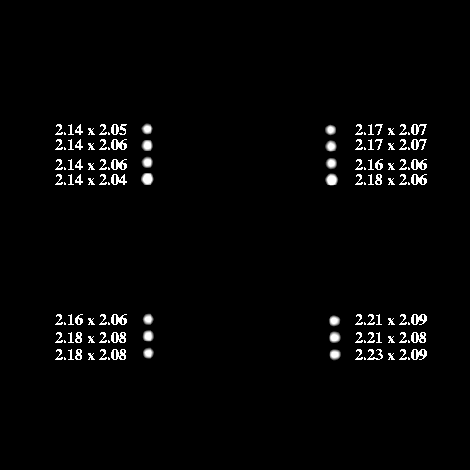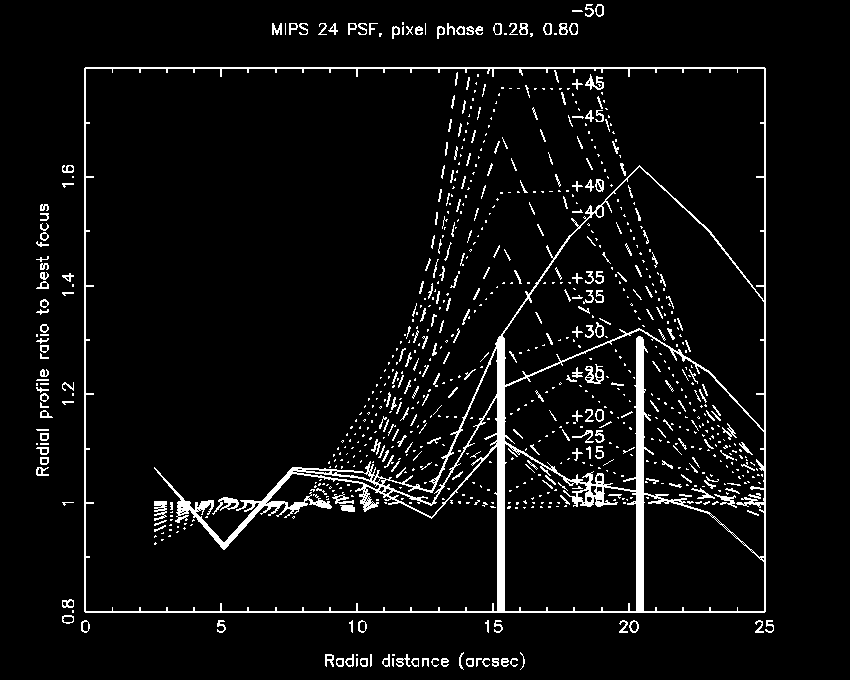Analysis
As in campaign D2, the data were processed through the DAT without any problems, and then
left-right flipped. Efforts to use mips_enhancer to remove distortion from the images
did not meet with much success, due to the very limited time available to test the
software with actual CTA images. Eventually it was determined that the enhancer was
correctly restoring images to a rectilinear grid, but that sampling effects were
blurring the PSF by an amount larger than the FWHM variations in the original (distorted)
images. As a result, there was no advantage to removing the distortion from focus
images before PSF reconstruction.
The 24 micron focus determination is based on analysis of structure in the second dark
Airy ring. Specifically, the radial profile of the observed star image is compared to
radial profiles of model PSFs with different amounts of defocus. Ideally the observed
profile would directly overly one of the model curves; but imperfect centering, imperfect
flat fielding and background subtraction, and unmodeled optical or detector effects
prevent this from happening. Instead, the observed radial profile crosses several of
the model curves, and thus will be consistent with a range of defocus values. The
radial profiles of the data and the models were calculated using the fortran program
"mips24_focusdeter128a". This program subtracts background from the image; renormalizes
the star to unit flux; assigns each image pixel to a radial bin; forms the radial profile
from an azimuthal median of the image values in each radius bin; and normalizes the
radial profiles against the radial profile of the in-focus SIRTF Tiny Tim model PSF.
As in campaign D2, we chose to work only with the data on K star HD 53501.
The first step in the focus analysis was to select only the dither positions from the
upper left quadrant of the 24 micron array for analysis. These four showed the least
image distortion (see Figure 1), so using them would minimize the effects of uncorrected
distortion on the focus results. The star was observed as a four-position cluster
target with large 3.5 pixel dithers, so four sets of upper left quandrant dither
positions (16 positions total) were available for analysis. Since two cycles of 24
micron photometry were performed on the star, two exposures were made at each of the
16 preferred dither positions. These two images at each position were combined into
a single coadded image with cosmic ray rejection (t= a+b - abs(a-b)). These sixteen
coadded exposures were the basis of all further focus analysis.
The next step was to measure the centroid of the star image in each of the 16 coadded
frames. IDP3 was used with Gaussian fitting. The sky background and its rms noise
were measured in apertures left and right of the star images; these aperture locations
were chosen to minimize the effect of the 3% vertical photometry gradient on the
background estimate at the stellar position. Total counts on the star were measured
and background subtracted. Values for the star centroid, total star counts, image
background, and rms background were recorded in parameter files for use by the radial
profile analysis program.
The data was then grouped in two different ways for the radial profile analysis:
Single dither position images
Model PSFs were calculated using the SIRTF Tiny TIM software version 1.3.
The specific pixel position measured for the star at each of the 16 dither positions
was used as an input to Tiny TIM. This assured that field-dependent aberrations
were properly accounted for in the PSF models. For each of the 16 dither postions,
model PSFs were calculated for a range of defocus values, forming 16 focus libraries
tailored to match the campaign E focus observations. All models were calculated
on a 10x oversampled grid, then simultaneously rebinned to the native 2.55" pixel scale
and translated so that the star centroid was aligned to within 0.02 pixel with the
star centroid in the MIPS 24 sky images.
Coaddition of all 16 dither positions
Coadding all 16 dither positions had the benefit of increasing the S/N of the
PSF in the images, enhancing the ability to measure brightness changes in the
second dark ring. A coadded PSF model is needed for comparison to the coadded
data. For each defocus position, we coadded all 16 of the 10x oversampled models
calculated above, then rebinned them to the native 2.55" pixel scale. The next
step was to build a single reconstructed image of the focus star from a combination
of the 16 dithered images. IDP3 was not able to automatically align and centroid
the images because the world coordinates in the fits headers were wrong. As a stopgap
measure, the JPL spica package was used to automatically find the centroids of the
largest bright object in the field above a specified isophote. The images were
then shifted and medianed on a 4x oversampled grid, yielding a reconstructed image
of HD 53501. This oversampled image was then resampled back to the native 2.55 arcsec
per pixel scale, and in the process shifted so that the star centroid coincided
with the centroid of model PSF in the coadded focus library.
Results

Figure 1: Coaddition of 30 separate
dither frames from the first cluster target position, for K star HD 53501.
The PSF FWHM values are given in pixel units, and were measured by Gaussian fitting
in IDP3 using an aperture of 6 pixels radius. The numbers give the FWHM along
the X and Y axes of the detector array, respectively.
In the above figure, one can see how the apparent size of the MIPS 24 image
core varies with dither position in the standard small-field photometry AOT. The
larger image size the in X direction is fully consistent with pre-launch expectations
for different plate scales in the X and Y directions: 2.4932 arcsec/pixel in X, and 2.5981
arcsec/pixel in Y from ray tracing (J. Keene, personal communication). The variation
of the FHWM with field position is due to higher order distortion terms.
We now show five radial profile plots comparing the observed 24 micron PSF with SIRTF
Tiny TIM models. In these plots, the sky data is represented by three solid lines.
The central line is the median radial profile, and the upper and lower solid lines
represent "error bars" to the median profile. The errors are calculated for +1 and -1
sigma changes in the sky background level, and do not include systematic effects.
The dashed lines are the family of curves for model PSFs at negative focus positions,
and the dotted lines are the same but for positive focus positions. The two vertical
bold lines define the inner and outer boundaries of the second dark Airy ring, and
thus bound the region of interest for the data/model comparison. If the SIRTF
Tiny Tim models were exactly correct, if there were no systematic normalization
or alignment errors in the radial profiles, and if MIPS was in perfect focus, then
the median radial profile would appear as a flat horizontal line at radial profile
ratio value = 1.

Figure 2: Radial profile of MIPS 24 micron PSF using the coaddition of two 3 second
exposures taken at pixel position 38.3, 84.7.
The above result isn't very good - the median observed profile doesn't stay
within the family of defocus curves; the upper error bar profile actually
crosses all the model defocus values !

Figure 3: Radial profile of MIPS 24 micron PSF using the coaddition of two 3 second
exposures taken at pixel position 38.3, 89.3.
This result is usable - the median radial profile travels near the -20 curve.
But the error bars allow a huge range of models.

Figure 4: Radial profile of MIPS 24 micron PSF using the coaddition of two 3 second
exposures taken at pixel position 38.3, 93.8.
This reslt is usable - the median radial profile travels near the +25 to +30
curves. But the error bars allow a huge range of models.

Figure 5: Radial profile of MIPS 24 micron PSF using the coaddition of two 3 second
exposures taken at pixel position 38.4, 80.1.
This result is usable - the median radial provile travels near the -20 curve.
But the error bars allow a huge range of models.
With the four plots in Figs 2-5 above showing large errors, we spent a good deal of
effort to investigate how to get better agreement between the data and the
models. The background measurements and centroid determinations were re-checked.
We investigated whether an error in the assumed plate scale might lead to
errors in the radial profile comparison; the SIRTF Tiny Tim models assume
square pixels, whereas both raytracing and IOC measurements show a small
scale difference between the X and Y axes. It was found that changing the
plate scale of the Tiny Tim models by 1% did not substrantially change the
quality of the radial profile fits. We also investigated whether the 24 micron
bandpass in Tiny Tim was correct; eventually we verified that it was,
although not until we had mistakenly believed for a few days that it wasn't.

Figure 6: Radial profile of the MIPS 24 micron PSF using the coaddition of
thirty-two 3 second exposure taken at various positions over the
upper left quandrant of the array.
This is the best result, largely because coadding the 16 dither positions has
give much better S/N on the background, and as a result, the random error bars
are much closer together. Based on what model defocus values the median curve
crosses, the formal focus determination is +20 to +33 or -26 to -36. An error
bar of +/- 15 microns still applies to each of these ranges, It seems clear
that MIPS is not at zero defocus.





